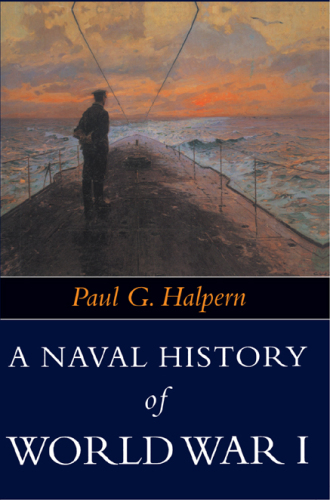oleebook.com
A Naval History of World War I de Halpern, Paul G
de Halpern, Paul G - Género: English
Sinopsis
There have been a number of studies published on the activities of British and German navies during World War I, but little on naval action in other arenas. This book offers for the first time a balanced history of the naval war as a whole, viewed from the perspective of all participants in all major theaters. The author's earlier examination The Naval War in the Mediterranean, 1914-1918, centered on submarine activities and allied efforts to counteract this new menace. With this welcome sequel he again takes the reader beyond those World War I operations staged on the North Sea. Halpern's clear and authoritative voice lends a cohesiveness to this encompassing view of the Italians and Austrians in the Adriatic; the Russians, Germans, and Turks in the Baltic and Black Seas; and French and British in the Mediterranean.
Important riverine engagements--notably on the Danube--also are included, along with major colonial campaigns such as Mesopotamia and the Dardanelles. The role...
Libros Recomendados - Relacionados
Reseñas Varias sobre este libro
Survey of the maritime and riverine operations of the Great War (1914 1918) at sea between the Entente (primarily Britain) and Central (primarily German) powers.
German blockade runner, cargo submarine, Deutschland entering Baltimore Harbor (USA), 1916.
My dead tree version was 591-pages. It had a US 1994 copyright. This book includes Footnotes, bibliography, and an Index.
Paul G. Halpern is an American naval historian and documentary editor. He has written about 10-books on WWI naval history. This is the first book Ive read by the author.
This book was an intermediate work. Its strongly recommended having a background knowledge of WWI and early 20th century maritime history before reading this book. Familiarity with period naval tactics and doctrine would also be helpful.
TL;DR Synopsis
A Naval History of World War I is a compact history of the Great War at sea. Its greatest strength is that it covers theaters of naval operations in some detail typically omitted from more general histories. It provides an overall naval strategic, operational, and tactical consideration for those theaters. In addition, blow-by-blow descriptions of significant engagements pointing-out the: doctrinal, organizational, technological or weather reason for victory or defeat in-theater are given.
However, the book is somewhat uneven in its level-of-detail. The authors favorite theater is the Mediterranean. It receives a lot of attention. Technical details of armaments superseded, other tech aspects of operations, except for with respect to submarines. Its also light on biographical analysis of the primary influencers of both the Entente and Central Powers and their organizational and professional conflicts in evolving Grand Strategy. Finally, the book had several minor copywriting errors.
Yet, having read this book, I received more than one revelation on WWI at sea. This was possible, by being able to compare and contrast similar operations in the less well-known theaters and at different points in the war. In general this book gave me a deeper understanding of the naval battlespace of WWI.
The Review
Halpern wrote this book to describe theater-by-theater the naval operations by all the combatants, both major and minor during WWI. The organization is a hybrid of geographical and chronological. For example, the primary North Sea Theater, later the Atlantic Theater, and the secondary Mediterranean appear a few times, both at the beginning, middle and toward the end. Minor theaters, the riverine Danube and the Tigris/Euphrates only appear once. The majority of the book involves the theater operations of the major naval power, the British Empire. Secondly was the primary British opponent, Imperial Germany. Thirdly and almost equally covered were Austria-Hungary and Imperial Russia. Then came: France, The Ottoman Empire, Italy and Japan. Finally, there was also scant mention of the minor engaged powers and Neutrals: Bulgaria, Rumania, Serbia, Portugal, Sweden, Denmark, the Netherlands, etc..
In general, the books prose was good. Its level was more approachable than many academic military histories, but more technical than popular histories. Although, the book was not as well edited as I expected. I found several grammar errors and a large typographical error that proper copyediting should have caught and corrected.
The book assumed an understanding of early 20th Century naval history. It could be technically dense in places. For example, naval artillery and range finding was discussed in detail. wise, period naval tactics, techniques and procedures were discussed with only a hint of "how to". In addition, the high-level strategy of the powers and the geography of the theaters naval operations and their affect was discussed using naval terminology. (Reading this, you were expected to know your port from starboard.)
The presentation was only somewhat even throughout in its level-of-detail. I was disappointed with the numerous instances of, it is beyond the scope of the discussion. This invariably occurred, when the author touched on something I found interesting, the logistics of shipbuilding vs. something he found interesting, such as mine warfare. However, these literary instances of "moving right along", provided me with leads for further reading. This was made easy through the well done Bibliography.
I also thought the book would have benefitted from a greater discussion of the varied geographies of the theaters. Although, a few times (but not all!) the hydrographics of the theater were discussed. For example, the Dalmatian side of the Adriatic was crystalline clear to a great depth (something I've noted in-person), making Austro-Hungarian sub-hunting very effective. The Italian side was murky with silt, abetting lurking Austro-Hungarian and German submarines.
Naval history is about charts and maps. Use of maps was barely adequate. It could have been greatly improved. The maps were commercially sourced, line maps, oriented toward land-based, not naval, geo-location. In addition, important topographical features are omitted from them. Their presentation and annotation poorly supported the narrative. Presentation included placing all the maps at the end of the book, vs. within or at the beginning of the chapter they provide reference for. Many of the place names found in the narrative were not on the maps. A period Atlas with place names was needed to be kept on-hand for reference of geographical features. This was particularly needed in the lessor known theaters the Baltic and Tigris/Euphrates.
Gulf of Riga, including Moon Bay Map I used for eastern Baltic Sea.
Note, the 1900s Germanic place names used in the books narrative have since been renamed by the Baltic States.
There were no photographs, and no diagrams. Line diagrams of the lessor known vessels of the conflict would have been greatly appreciated. Most readers would be familiar with Dreadnoughts and Battle Cruiser-class capital ships. They remained the same thought-out the war. However, in four-years of war, the quickly-built, Destroyer-class changed greatly, almost tripling in average tonnage. I spent several hours poring over warship pictures on the Internet to supplement the narrative describing the evolution in importance of the lesser known light craft during the naval guerrilla warfare of the Narrow Seas. For example, representative diagrams of: sloops, yachts, trawlers, mine sweepers, torpedo boats and destroyers would have been helpful.
Chart and graph usage was non-existent. Their usage would have benefited the reader, in particular given the numerical and technical nature of some of the narrative. At several points, I wished the author had read, Tuftes The Visual Display of Quantitative Information
all military histories, this was a story of: men, machines and organizations in contention.
Halpern expected the reader to already have a passing familiarity with the key naval figures: Admiral of the Fleet Jellicoe, Admiral of the Fleet Fisher, Großadmiral von Tirpitz, and Admiral von Hipper, Et al.. However, he did not delve deeply into the political aspect of individuals effect on shaping strategy and their politics. Individuals were more ly to be mentioned in the context of command in operations.
In general, Halpern was successful in describing the technology of the naval war machines and their application and evolution during the war. No navys fleet fought the war they prepared for. The capital ships designed for the Mahanian Decisive Battle were too valuable to risk. The technology of the torpedoes and underwater mines also made them very vulnerable to light vessels including submarines. This resulted in the naval guerrilla warfare between submarines, destroyers and lesser vessels, and eventually included ever more capable aircraft in the later part of the war. Technology should also be seen to include Signals Intelligence, espionage, and code breaking. This includes developing new techniques for dealing with information differently than before the war. I thought Halpern was less successful in describing the shipbuilding, maintenance and repairs, both naval and merchant marine had in feeding the war machine. In an environment of scarcity (labor, time, and materials) and contention between priorities (Army vs. Navy), why was it that only the Central Powers had problems getting ships built? I also would have d to have seen a more in-depth compare and contrast in the design of German vs. British capital ships. The German capital ships were almost unsinkable. Whereas, British battle cruisers tended to blow up when roughly handled by enemy gunfire.
Inspection of organizational behavior was heavily oriented toward Navy-on-Navy both allied and opponent. Organizationally, Fleet Admirals were only superficially shown to be in contention with their governments, and their own services organization. This is best documented by the British and secondly by the Germans only. However, there is a particularly interesting description on the British Navy reversing its position on convoys. Its a good example of organizational change. wise, but not as well done, is the description of the German Navys cannibalizing the crews of the languishing surface fleet to man the submarine fleet for unrestricted submarine warfare. Submarines manned by young, aggressive, small in number, highly trained crews superseded the iconic battleships in prosecuting the war.
Within the context of the above, the greatest strength of this book was placing naval operations of all theaters in a position to compare and contrast them with a somewhat even level-of-detail. In particular, less well known theaters of the war. Every student of the war knows it was decided on the Western Front. That can also be extended to the North Sea theater and the British Blockade of the Central Powers. There, they know about the Battle of Jutland , the closest the world came to a Mahanian Decisive Battle, between battleships. However, the naval war in the Baltic and Black Seas two very different theaters with different conditions between the same Imperial Germans and the Imperial Russian opponents, is almost unknown. wise, the naval war between the Austro-Hungarians, their German allies, and the Entente Mediterranean powers in the Adriatic Sea is wise not well known. In addition, the riverine operations on the Danube mega river between Serbian Belgrade and the Black Sea provided a startling contrast to saltwater amphibious operations and naval gunnery support. It can be seen that not all the naval battles of WWI were fought between British tars and German sailors.
This book was a story of: men, machines and organizations in contention. Its theater-oriented focus showed that the naval conflict was greater and more diverse than just that between the Royal Navy and the Imperial German Navy in the Atlantic Theatre. Neither the Entente or Central Powers fought the naval war they prepared for. The similar operations in different theaters by different opponents showed how both sides innovated or failed to innovate technologically, tactically and operationally in different ways during the relatively short 4-years of the war. As a survey, I think the book was successful, if somewhat uneven. In particular geography and the presentation of quantitative information could have been better. For example, the maps sucked for what they had to do. However, in a relatively short number of pages, I came away with both a broader and deeper appreciation of the WWI naval war. This is a worthwhile read for someone who already has a background in 20th Century military and diplomatic history, particularly naval military history and wants to know more about the naval war fought during WWI beyond the North Sea and North Atlantic. Although, there was still a lot written in it about German submarines.
Readers of this book may also be interested in: Fighting the Great War at Sea: Strategy, Tactic and Technology by Norman Friedman (my review), Castles of Steel by Robert K. Massie and The Rise and Fall of British Naval Mastery by Paul Kennedy.6 s Mark1,056 114
Traditionally studies of the naval battles of the First World War have focused primarily on the non-event of the confrontation between the British and German battle fleets in the North Sea. While relevant in the context of the tensions that led to war and important for several reasons, such predominance creates a distorted impression of the war at sea as being one that was mainly fought around the waters off Great Britain. In fact, the naval history of the First World War is one that well justifies the title of the conflict overall, as ships of the various sides fought each other in critical struggles across every part of the globe.
In this respect, Paul Halpern is the ideal person to write an overall history of the conflict at sea. A longtime naval historian of the era, he approaches the subject from his earlier work studying the First World War in the Mediterranean, a long-overlooked front that engaged many navies not traditionally covered in histories of the war. This equips him with a background and perspective that is perfectly suited for a broader study of the naval history of the war, one that he displays on nearly every page. Beginning with a short survey of the navies of the major powers, he goes on to discuss the exciting pursuits of the first months of the war before taking the reader on a tour of the many neglected fronts, from the Black Sea to the Danube River. To accomplish this, he draws upon his own considerable work as well as many of the often-neglected official histories and memoirs, many of which require the surmounting of numerous language barriers.
The war that emerges within these pages is not a staid affair of massive dreadnoughts glaring at each other from their respective ports, but a series of struggles of cruisers, destroyers, submarines, and river boats often characterized by dash and ingenuity. Though Halpern recounts many of these clashes, his focus is primarily strategic, as he explains how each of these battles and campaigns played a role in the broader effort by the various sides to win the war. His analysis is insightful, explaining why these oft-ignored struggles mattered in the grand scheme of conflict. Nor does he overlook the traditional subject of the stand-off between the Grand and High Sea Fleets, giving them due attention as a critical component of his topic.
All of this makes Halperns book a truly impressive study of the First World War at sea. Encompassing as it does issues of geography, diplomacy, and society, it is indeed not just an account of battles and campaigns but a real naval history of the conflict. Such an inclusive scope can make it easy to quibble about minor errors such as typos, or about what was left out (my personal complaint is the lack of a concluding chapter examining some of the post-war consequences of the experiences he describes), but none of this should overshadow the magnificence of Halperns achievement. Simply put, this is the single best history of the naval conflicts of the First World War, one that is an indispensable starting point for understanding the conflicts at sea and the role it played in the war overall.2 s Jesse Callaghan154 3
Exceptional work of scholarship. Certainly the best single volume history of the first world war at sea. Good to read alongside Fighting the Great War at Sea : Strategy, Tactics and Technology by Friedman. Joe Hodes33
An excellent, comprehensive history of the war at sea. It is amazing the thrust and parry of actions outside the few, well known theaters and events (the Goebel affair, the Dardanelles, Jutland, the U-boat war, etc.). Ivan43
Exhaustive. Detailed. Dry.p Michael Baker4 2
I actually only waded through about a third of it. Its really more of a textbook than a reading book. I picked a number of ideas for naval engagements that will make their way into my games. David Luke45 4
Autor del comentario:
=================================












